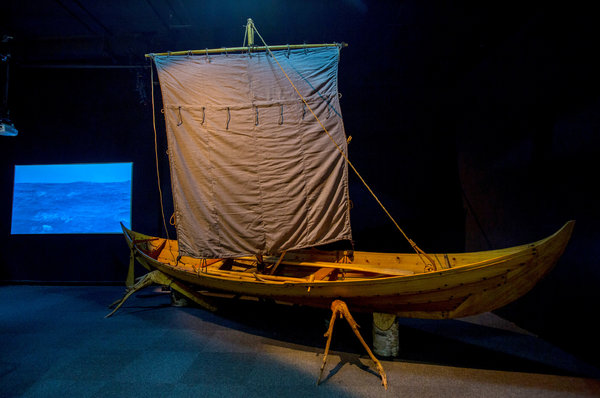The new “Vikings” exhibition at Discovery Times Square is, in a sense, built around something that isn’t there.

The exhibition, which opens on Friday, was organized by the Swedish History Museum in conjunction with MuseumPartners in Austria, and the people behind it really want you to know that during the 350 years (750 to 1100) that Viking culture flourished, horned helmets were never a thing. They have amassed 500 artifacts — some copies; many the genuine article — to make the point.
There’s not a horned helmet among them (unless you count an amusing sight gag as you exit), because no such headpiece has ever come out of an archaeological dig. The ubiquitous headgear often associated with Vikings, we’re told in the exhibition, actually came out of the imagination of an 1876 costume designer staging a Wagner opera. And that’s not the only misperception this exhibition is intent on correcting.
The first thing you see in the introductory film as you enter is a farming scene. Raiding was certainly part of what Vikings did, but it is de-emphasized here — perhaps too much so — in favor of displays that highlight social and religious life and try to give women their due.
Countless fictional portrayals might have left the impression that Viking culture was somehow 90 percent male, wild-haired and sword-wielding, but of course it wasn’t, as the jewelry and many other women’s artifacts here attest. The now-rusted keys on display, we’re told, were often carried by women, because with men frequently on the road, they ran the farm.

What’s most interesting about the exhibition, though, is the way it places Vikings within the evolving world. It includes, for instance, a shell found on Gotland, the Swedish island, that came from the waters off distant Cyprus, because one thing Vikings were good at was getting around.

From Scandinavia, the Vikings vikinged far and wide, encountering other emerging cultures. The exhibition is organized by themes rather than chronologically, and the cross-cultural pollination is especially clear in a section on religion. Norse gods and Christian symbolism combine on brooches and pendants, tangible evidence of the kind of slow cultural conquest or merging that is harder to dramatize than a plain old military invasion but fascinating to contemplate.

The ships that made all this roaming possible are well represented. There’s a reproduction of a Viking boat, but just as compelling is a display that speaks to the archaeologist’s frustration: So many materials, including wood, deteriorate in a harsh climate. The display — “We call it the ghost ship,” Ms. Hejll said — consists only of what might be left of a ship at an archaeological dig: the metal hardware that held it together. Dozens of weatherworn rivets and other pieces of ancient hardware dangle from strings, creating the shape of a vessel; only the actual vessel is missing.

The New York Times]
The exhibition is geared toward a general audience, with several interactive features likely to appeal to children. One especially illuminating one involves shipbuilding. It presents a graphic display of a landscape, then asks you to select what you’d need to build a Viking ship. Rope? Sure — make that choice and all the horses in the landscape lose their tails, because horsetail hair was used for rope. Wood? Of course — make that selection and all the trees disappear. Deforestation, it turns out, was not just an Industrial Age problem. The Viking commitment to a seafaring life was also a commitment to expend a lot of natural resources.

The New York Times]
The Vikings Exhibition runs from Feb. 5 – Sept. 5, 2016, at Discovery Times Square: 226 West 44th Street, Manhattan, NYC.
Author: Neil Genzlinger | Source: The New York Times [March 02, 2016]